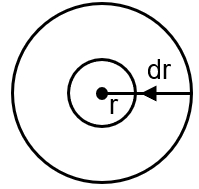A charge Q is uniformly distributed over the surface of non-conducting disc of radius R. The disc rotates about an axis perpendicular to its plane and passing through its centre with an angular velocity w. As a result of this rotation a magnetic field of induction B is obtained at the centre of the disc. If we keep both the amount of charge placed on the disc and its angular velocity to be constant and vary the radius of the disc then the variation of the magnetic induction at the centre of the disc will be represented by the figure.
Integrating we get

To understand how the magnetic field at the center of a rotating charged disc varies with its radius, let's break down the problem step by step.
Step 1: Magnetic Field Due to a Rotating Charged Disc at Its Center
A disc of radius R has a uniform surface charge density σ. The total charge Q is constant, so σ = Q / (πR²). The disc rotates with angular velocity ω. Each point on the disc acts like a current loop. The magnetic field at the center due to a ring of radius r and width dr is given by the formula for a circular loop: dB = (μ₀ / 2) * (dI / r), where dI is the current due to the ring.
Step 2: Find the Current dI for a Ring
The charge on a ring of radius r and width dr is dq = σ * 2πr dr. As the disc rotates, this charge moves, creating a current. The current dI = (charge per unit time) = (dq) * (frequency) = dq * (ω / 2π) = (σ * 2πr dr) * (ω / 2π) = σ ω r dr.
Step 3: Magnetic Field Contribution from the Ring
Substituting dI into dB: dB = (μ₀ / 2) * (dI / r) = (μ₀ / 2) * (σ ω r dr / r) = (μ₀ / 2) σ ω dr.
Step 4: Integrate to Find Total Magnetic Field B
Integrate dB from r = 0 to r = R:
Step 5: Substitute σ in Terms of Q and R
Since σ = Q / (πR²), substitute:
Step 6: Analyze Variation with R
From B = (μ₀ Q ω) / (2π R), we see that B is inversely proportional to R, i.e., B ∝ 1/R. Since Q and ω are constant, as R increases, B decreases. The graph of B vs. R should be a rectangular hyperbola in the first quadrant, starting from a high value at small R and approaching zero as R becomes large.
Final Answer: The correct figure is the one where B decreases hyperbolically with increasing R.
Magnetic Field Due to Current Loops: Understanding how current-carrying loops produce magnetic fields is fundamental. For a circular loop, B at center is μ₀I/(2R).
Surface Charge Density: Uniform distribution on surfaces and how it relates to total charge and area.
Integration in Physics: Summing infinitesimal contributions, like here for rings on a disc, is a common technique.
Magnetic field at center of a circular loop:
Surface charge density:
Current due to rotating charge element: dI = (dq) * (ω / 2π)
Magnetic field at center of rotating disc: